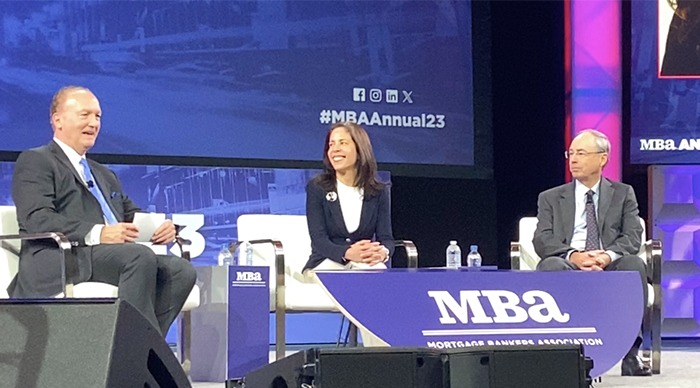
Freddie Mac, Fannie Mae Execs Talk Repurchases, Updates and New Resources

(From left: Jones, Almodovar and Hutchins. Picture by Anneliese Mahoney)
PHILADELPHIA–Fannie Mae and Freddie Mac executives updated the industry during a general session at the Mortgage Bankers Association Annual Convention & Expo here Oct. 16.
Freddie Mac President Mike Hutchins announced a new resource–DPAOne.
“There are a vast number of governmental programs that are out there,” said Mike Hutchins, President of Freddie Mac, citing about 2,500 programs at the state level intended to help borrowers with downpayments. “Unfortunately, these programs are very unique. And there hasn’t been a way of putting them all together to match the right program with the right borrower at the end of the day.”
DPAOne is a program that is able to do exactly that, Hutchins said. It’s free, and will help match borrowers to relevant programs.
In addition to the announcement, Hutchins and Fannie Mae CEO Priscilla Almodovar provided updates and thoughts on the landscape in the session moderated by 2024 MBA Chairman Mark Jones, President of Union Home Mortgage.
Top of mind in the industry: repurchases.
Hutchins says Freddie Mac has been working to improve its own internal processes.
“We saw the maximum [not acceptable quality] levels at the end of last year. And obviously there’s a lag between that and repurchase requests–that hit a maximum in the first quarter of this year,” Hutchins said. “Since then, most recently, we’ve seen a 30% decline in NAQ levels. More importantly, we see more than a 50%–almost 60%–decline in repurchase requests from Freddie Mac.”
Hutchins said the GSE will continue to improve its processes, among other actions.
“We hear you,” Almodovar said, referring to repurchases as a “last resort.” Almodovar said Fannie Mae is also looking at its processes related to repurchases, and similarly has seen rates drop since the peak of March this year.
She encouraged lenders to use Fannie Mae’s certainty tools, as their defect rates are significantly lower.
Both GSEs have made reaching new borrowers a priority, and Jones asked the executives for updates on those efforts.
Almodovar noted there are 44 million renters in the United States, and Fannie Mae has concentrated some specific efforts there.
For example, in September 2022, Fannie Mae began a pilot program to work with property owners to report positive rent payments. “I’m happy to report that a year later, 23,000 renters in this country have established a credit score because of our efforts,” Almodovar said. “There are 5,300 borrowers who became eligible because of our ability to see them.”
Moreover, Almodovar highlighted Fannie Mae’s work with the Consumer Data Industry Association on efforts to report and count rent payments.
Hutchins said Freddie Mac is also now counting rental payments. Additionally, the GSE has started pursuing some further automated efforts to confirm assets, and examining borrowers’ bank records for more information about cash flow and payments.
Another hot topic: alternative credit scoring.
Almodovar acknowledged some of the complications for Fannie Mae; it’s hosting forums with the Federal Housing Finance Agency looking for feedback. “We are continuing to work with you. It’s a big lift, and we’ll get there together,” she said.
Hutchins echoed many of the same sentiments, with a call for participation and feedback.
“It is a big lift. And we know that and like Fannie, we have a massive number of programs that are internal that that will have to change,” Hutchins said. “But we’re committed to work together with you. We’re committed to work together with FHFA and Fannie Mae to have as expeditious but seamless process as possible.”
